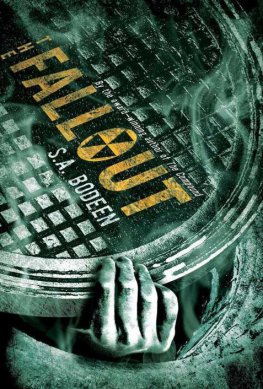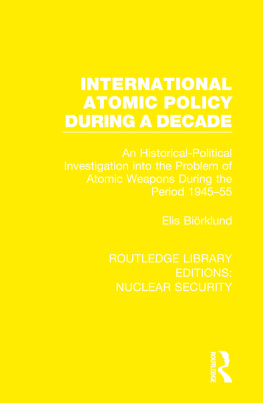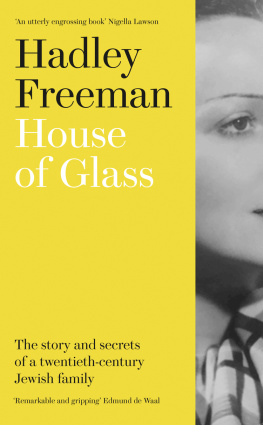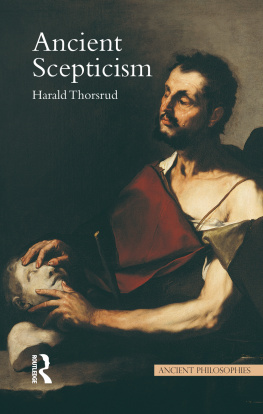
Contents

2018 Meri-Jane Rochelson. Published by Wayne State University Press, Detroit, Michigan 48201. All rights reserved. No part of this book may be reproduced without formal permission. Manufactured in the United States of America.
Transcript of family interview with Eli G. Rochelson 2018 Burton L. Rochelson and Meri-Jane Rochelson.
Library of Congress Cataloging Number: 2018933409
ISBN 978-0-8143-4021-9 (paperback)
ISBN 978-0-8143-4494-1 (case)
ISBN 978-0-8143-4022-6 (ebook)
Wayne State University Press
Leonard N. Simons Building
4809 Woodward Avenue
Detroit, Michigan 48201-1309
Visit us online at wsupress.wayne.edu
For David, Danny, Ellis, Serafima, Jordan, Sam, Karl, and Jack and all who are yet to be
And in memory of Borya
Preface and Acknowledgments

THIS BOOK, THE life story of Eli G. Rochelson (19071984), takes as its starting point the story as he told it himself in interviews forty years ago with his son, my brother, Burton L. Rochelson. Since then, a great many interviews have been done by Holocaust survivors, and a great many books have been written. Each narrative adds something to the historical record and keeps the details of experience alive. Elis Story begins long before the Holocaust and ends long after, telling of a life that was more than suffering and survival. In the Introduction that follows, I describe the reasons for some of the choices I have made. Here, I wish to thank all those who made the book itself possible. This was a very large group, and I hope that anyone I may have omitted will forgive me.
This book was many years in the making, beginning with the interviews done by Burt. Indeed, Burt has been a partner in this enterprise from the start, and it is not only because of the interviews that I could not have done the book without him. My work on the manuscript began in earnest in 2010, after our mother died and Burt and I went through the many papers that she, our father, and other relatives had amassed. Thus, I owe a deep debt of gratitude to Pearl and Eli Rochelson themselves, and to Ida and David Robinson, Elis sister-in-law and brother in the United States, who recognized that photographs and documents needed to be preserved. In the seven years I have been at work on Elis Story, Burt and I have gone through and shared many of those items together; he has reviewed drafts; and we have discussed and occasionally argued. Most importantly, Burt has encouraged me throughout this lengthy and complex task. The book belongs to us both.
Of course, the book would not have appeared without valued support from institutions and other individuals. I am grateful to Targum Shlishi, a Raquel and Aryeh Rubin Foundation, for a grant that enabled me to travel to do research at libraries and archives. I am also indebted to the extraordinary librarians, archivists, and other staff at those institutions. These include Gunnar Berg, archivist at the YIVO Institute for Jewish Research; Megan Lewis, Vincent Slatt, Elliott Wrenn, and Ron Coleman, librarians at the United States Holocaust Memorial Museum (USHMM); Anne-Marie Belinfante, specialist in the Dorot Division of the New York Public Library; the staff of the United Nations Relief and Rehabilitation Administration (UNRRA) Archives in New York; the librarians and staff in the research division of Yad Vashem; and Galina Baranova, director of the Lithuanian State Archives. Sara-joelle Clark of the Survivors Registry at the USHMM long ago sent me copies of documents from the International Tracing Service held at the museum. Robert Ehrenreich had suggested not only that I get those but also that I visit and search the archives myself. He was right on both counts. I am also grateful to the staff at the International Tracing Service in Bad Arolsen, Germany, who replied to my very earliest requests for information in 1989. My warmest thanks, as well, to Robin Harp of the USHMM Photo Archives, to Emanuel Saunders of the Yad Vashem Photo Archive, to Charlotte Bonelli of the American Jewish Committee, and to Yedida Kanfer of the Jewish Family and Childrens Services Holocaust Center in San Francisco for permission to reproduce or quote from materials in their collections.
I owe enormous thanks to a number of Holocaust survivors who gave of their time to talk with me personally and to give me information about their own experiences, as well as their connections to my father. These include Masha Zulzberg Lidor, Shalom Eilati, and Moshe Kravetz in Israel, and Josef Griliches, Nissan Krakinowski, Sol Lurie, Tonia Rotkopf Blair, and Rabbi Laszlo Berkowits in the United States. I also learned a great deal in conversation with family members: Nissan Krakinowskis daughters Pessie and the late Shayndee Krakinowski Altman, and Sharon Caspi and Meirav Furth, daughter and granddaughter of Masha Lidor. I have learned, too, from the families of people that my father knew in Kovno: Lily Perry, Thelma Silber, and Janina Pace, widows of three of Elis doctor friends, and Bella and Benny Pace; Sharon Silber, Joanne Silber Ronay, and Bobbie Silber Lamont; Cindy, Ken, and Jeff Perry; Paulina Rosenstein; and Dan A. Nabriski, children of several of the Kovno doctors.
Family genealogists, in particular Eric M. Bloch and the late George Rockson, both building upon the work of the late Francis R. (Bob) Wilson, as well as Deana Sanditen Maloney, have helped me enormously in this project. Bette Stoop Mas, a member of the LitvakSIG listserv, was exceptionally helpful in enabling me to discover a previously unknown branch of my paternal grandmothers family, and in the process she introduced me to the outstanding assistance provided by the Family History Library of Salt Lake City, operated by the Church of the Latter Day Saints. LitvakSIG, itself, has been a treasure, and I have learned an enormous amount through discussion posts and connections made through them, as well as through the Kaunas and Suwalki District Research Groups. The tireless researchers in these groups, headed by Dorothy Lievers, Eden Joachim, and Ralph Salinger, post a wealth of data to contributors before it is available on JewishGen.org, another outstanding resource of which I made extensive use. My cousin Greta Minsky expanded my knowledge of Tulsa family history and explained important connections I had not been aware of between my Rochelson family and the Fenster branch. Cousin Debi Sanditen helped me with Sanditen connections, while Nathan Bloch, grandson of Ben Bloch, helped me understand the history of the Midwestern branch of the family. On the Lubovsky side, Pierre Pizzochero provided a wealth of information on European cousins, and Bill and Sandy Esner introduced mein a few cases, literallyto American cousins I had not known existed before. Gerald Stern, an Englishman who replied to my e-mailed request about a name in his online family tree, set in motion my reconnecting with Masha Lidor and her family.
I have gained extremely valuable scholarly advice and support from Marsha Rozenblit, as well as from Natalia Aleksiun, Oren Stier, Kenneth Waltzer, Deborah Lipstadt, Ellen Cassedy, Margaret Stetz, and a number of other scholars whose papers I have heard or whose work I have read; comments from the anonymous readers for Wayne State University Press helped me to make this a better book than it might have been. Ralph Berger, a dear friend and the coauthor of his own parents memoir,
Next page










